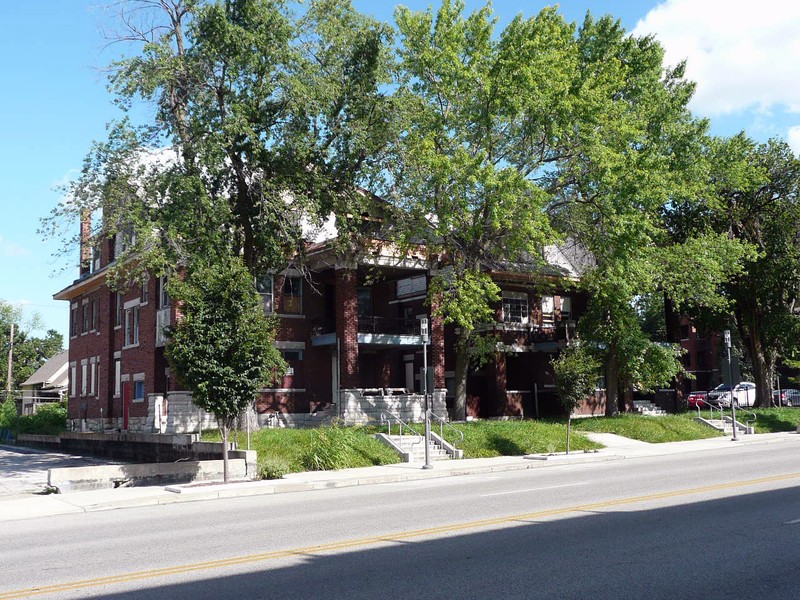Kuehne-Schmidt Apartments
Introduction
Text-to-speech Audio
Kansas City's Kuehne-Schmidt Apartments were constructed in 1909 by area produce entrepreneur Charles Kuehne, and the twin apartment buildings remain today along a mostly commercially developed section of Main Street. Kuehne hired Architect Claude P. Schmidt, who designed the apartments using the square-brick column, colonnade style of apartment construction that was popular at that time. The style is defined as a multi-story, masonry buildings with one or more prominent multi-tiered porches. In addition to its unique design, the apartment speak to the socioeconomic changes occurring in Kansas City during the early twentieth century. The influx of middle-class residents to the city led investors to build several small- to medium-sized apartment buildings, usually outside the downtown area and near streetcar lines, allowing for easy access to and from the city's business center.
Images
Kuehne-Schmidt Apartments

Backstory and Context
Text-to-speech Audio
The Kuehne-Schmidt Apartments were constructed in 1909 as two-apartment flats for owner Charles H. Kuehne under the design of architect Claude P. Schmidt. The buildings have been well-preserved and stand as excellent examples of the square-brick column, colonnade apartment style. Beyond their architectural significance, the Kuehne-Schmidt Apartments represent a socioeconomic trend in Kansas City during the early twentieth century. Housing shortages inspired speculative developers to build several small- to medium-sized apartment buildings with four to twelve units, mainly catering to a rapidly growing middle class.
Charles Kuehne was born in Milwaukee in 1852 and came to Kansas City in 1882. In 1886, Kuehne formed a partnership in the general produce business with D.E. Smeltzer. Kuehne incorporated the Charles H. Kuehne Commission Company after Smeltzer died in 1902. In 1909, Keuhne hired Architect Claude P. Schmidt to build the now-historic apartment buildings. Schmidt was born in Germany in 1860 and emigrated to America in 1882, first settling in Omaha, Nebraska, where he worked as a carpenter. The following year, he moved to Kansas City and worked first as a carpenter before transitioning to a draftsman and then an architect. Schmidt served as lead architect or collaborated on at least twenty-five other projects in Kansas City from 1897 to 1924, including the Savoy Hotel, regularly frequented by President Harry S. Truman. He also designed numerous single-family homes, apartment buildings, commercial properties, and a church. Moreover, in 1897, Schmidt became a director of the American Savings & Loan Association, and then he took the position of president in 1928.
Schmidt designed the apartment buildings as colonnade apartment structures. In short, colonnade apartments are multi-story, masonry buildings with one or more prominent multi-tiered porches. In Kansas City, colonnades often included brick wall cladding, at least two self-sufficient units, and rose two and four stories high. Both of the Kuehne-Schmidt Apartments have nearly identical features, including the interior. Each floor contained a living room, sitting room, dining room, kitchen, and bathroom. The first and second floors have two bedrooms while the third floor has only one. The first floor also has a patterned, hexagonal tile foyer.
Apartment buildings like the Kuehne-Schmidt Apartments appealed to the influx of middle-class residents coming to Kansas City. The buildings usually arose on or near significant thoroughfares or streetcar lines, which provided the mainly middle-class residents quick and easy access to downtown workplaces and entertainment while also providing them a home in a less-congested, greener space -- a suburban setting.
After building the apartments in 1910, Kuehne took on a new partner and re-incorporated as the Kuehne-Chastain Commission Company. Kuehne's interests in the produce business culminated in The Golden West Celery and Produce Company. Located in California, the celery farm grew from twenty acres to six hundred acres. Kuehne died in 1916; he bequeathed his properties including these apartments to his wife, who owned the buidings until 1920.
Sources
Crawford, Janette Yost. The Kansas City Colonnaded Walk-up Flat: A History and Homage. Reform (blog). medium.com. Oct 28, 2014. https://medium.com/re-form/the-kansas-city-colonnaded-walk-up-flat-a-history-and-homage-a7a9695f5f5b.
Gardner, Tony. "Nomination Form: Kuehne-Schmidt Apartments." National Register of Historic Places. archives.gov. 2007. https://catalog.archives.gov/OpaAPI/media/63817473/content/electronic-records/rg-079/NPS_MO/07000040.pdf.
By Mwkruse - Own work, CC BY-SA 3.0, https://commons.wikimedia.org/w/index.php?curid=42300187
